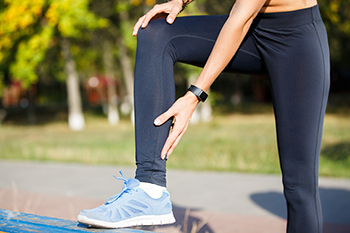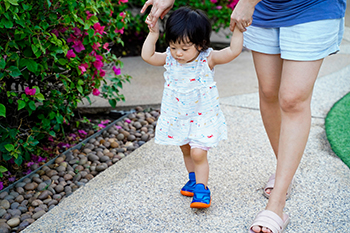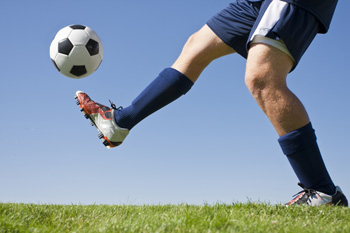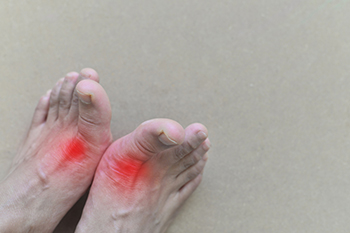

Achilles tendon injuries can affect anyone, but certain factors increase the likelihood of tendon problems. These factors include changes in an athlete's training schedule or intensity, shifts in playing surfaces or footwear, or having tight or weak calf muscles. Additionally, excessive pronation during walking or running, and chronic ankle instability may contribute to developing an Achilles tendon injury. An individual may be at a higher risk for these injuries from leg-length discrepancies, regular high-heel use, or intense training on hills. Increasing age, the use of specific antibiotics such as fluoroquinolones, and having high-arched feet may also lead to an Achilles tendon injury. If you have one or more of these risk factors and are experiencing recurrent pain or weakness in your heel or ankle, it is suggested that you visit a podiatrist.
Achilles tendon injuries need immediate attention to avoid future complications. If you have any concerns, contact Massimo Pietrantoni, DPM of Rochester Podiatry, LLP. Our doctor can provide the care you need to keep you pain-free and on your feet.
What Is the Achilles Tendon?
The Achilles tendon is a tendon that connects the lower leg muscles and calf to the heel of the foot. It is the strongest tendon in the human body and is essential for making movement possible. Because this tendon is such an integral part of the body, any injuries to it can create immense difficulties and should immediately be presented to a doctor.
What Are the Symptoms of an Achilles Tendon Injury?
There are various types of injuries that can affect the Achilles tendon. The two most common injuries are Achilles tendinitis and ruptures of the tendon.
Achilles Tendinitis Symptoms
Rupture Symptoms
Treatment and Prevention
Achilles tendon injuries are diagnosed by a thorough physical evaluation, which can include an MRI. Treatment involves rest, physical therapy, and in some cases, surgery. However, various preventative measures can be taken to avoid these injuries, such as:
If you have any questions please feel free to contact one of our offices located in Brighton and Greece of Rochester, NY . We offer the newest diagnostic tools and technology to treat your foot and ankle needs.

The question of when babies should start wearing shoes is a consideration that aligns with their developmental milestones. As a general guideline, infants typically are barefoot in their early months, allowing their delicate feet to explore and develop naturally. Shoes are introduced when babies begin to take their first steps, usually at the age of nine to 12 months. At this stage, shoes provide protection and support for those wobbly steps, aiding in balance and preventing potential injuries. Prioritizing shoes that are lightweight, flexible, and properly fitted is vital, ensuring the natural growth and formation of the feet. Soft-soled shoes with room for toes to move are recommended, promoting proper foot development. As children gradually transition to more stable steps, selecting shoes that accommodate their newfound mobility becomes an essential consideration for their comfort, safety, and continued healthy foot development. If you would like more information about what type of first shoes to buy for your child, it is suggested that you consult a podiatrist.
The health of a child’s feet is vital to their overall well-being. If you have any questions regarding foot health, contact Massimo Pietrantoni, DPM of Rochester Podiatry, LLP. Our doctor can provide the care you need to keep you pain-free and on your feet.
Tips for Keeping Children's Feet Healthy
If you have any questions, please feel free to contact one of our offices located in Brighton and Greece of Rochester, NY . We offer the newest diagnostic and treatment technologies for all your foot care needs.

Proper foot care is essential for soccer players, as their feet are their primary tools on the field. Just like a carpenter maintains their tools, soccer players must take care of their feet to perform effectively. Parents whose children play soccer should regularly check their children's feet for any issues and teach them to promptly report any discomfort. Common foot issues in soccer players include abrasions, athlete's foot, blisters, calluses, and corns. Additionally, bruises, cysts, ingrown toenails, toenail loss may also become concerning foot conditions. Less common but serious issues like broken bones, bone bruises, bone spurs, and sprains should be treated by podiatrists promptly. If you are a parent or player, it is suggested that you schedule an appointment with a podiatrist in advance to ensure proper care, if needed.
Ankle and foot injuries are common among athletes and in many sports. They can be caused by several problems and may be potentially serious. If you are feeling pain or think you were injured in a sporting event or when exercising, consult with Massimo Pietrantoni, DPM from Rochester Podiatry, LLP. Our doctor will assess your condition and provide you with quality foot and ankle treatment.
Common Injuries
The most common injuries that occur in sporting activities include:
Symptoms
Symptoms vary depending upon the injury and in some cases, there may be no symptoms at all. However, in most cases, some form of symptom is experienced. Pain, aching, burning, bruising, tenderness, tightness or stiffness, sensation loss, difficulty moving, and swelling are the most common symptoms.
Treatment
Just as symptoms vary depending upon the injury, so do treatment options. A common treatment method is known as the RICE method. This method involves rest, applying ice, compression and elevating the afflicted foot or ankle. If the injury appears to be more serious, surgery might be required, such as arthroscopic or reconstructive surgery. Lastly, rehabilitation or therapy might be needed to gain full functionality in the afflicted area. Any discomfort experienced by an athlete must be evaluated by a licensed, reputable medical professional.
If you have any questions, please feel free to contact one of our offices located in Brighton and Greece of Rochester, NY . We offer the newest diagnostic and treatment technologies for all your foot care needs.

Gout, a form of arthritis, manifests when urate crystals accumulate in the joints, causing intense pain and inflammation. While anyone can develop gout, certain factors increase susceptibility. Men, particularly those over 40 years old, are more prone, as are postmenopausal women. A family history of gout raises the risk, indicating a genetic predisposition. Lifestyle choices also play a pivotal role, and a diet rich in purines found in red meat, seafood, and alcohol can contribute to elevated uric acid levels. Obesity and medical conditions such as high blood pressure or diabetes amplify the likelihood of gout. Dehydration and certain medications may also tip the balance towards crystal formation in joints. The intricacies of gout's causes underscore the importance of proactive measures, including dietary adjustments, hydration, and lifestyle modifications. By understanding the factors and vulnerabilities associated with gout, individuals can take informed steps towards prevention and better management of this often painful condition. If you have developed gout, it is strongly suggested that you contact a podiatrist who can guide you toward effective management and pain relief techniques.
Gout is a painful condition that can be treated. If you are seeking treatment, contact Massimo Pietrantoni, DPM from Rochester Podiatry, LLP. Our doctor will treat your foot and ankle needs.
What Is Gout?
Gout is a form of arthritis that is characterized by sudden, severe attacks of pain, redness, and tenderness in the joints. The condition usually affects the joint at the base of the big toe. A gout attack can occur at any random time, such as the middle of the night while you are asleep.
Symptoms
Risk Factors
Prior to visiting your podiatrist to receive treatment for gout, there are a few things you should do beforehand. If you have gout you should write down your symptoms--including when they started and how often you experience them, important medical information you may have, and any questions you may have. Writing down these three things will help your podiatrist in assessing your specific situation so that he or she may provide the best route of treatment for you.
If you have any questions, please feel free to contact one of our offices located in Brighton and Greece of Rochester, NY . We offer the newest diagnostic and treatment technologies for all your foot care needs.